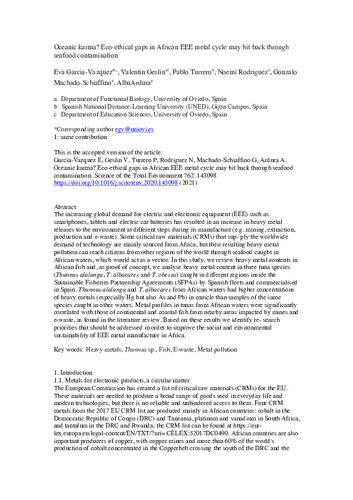Oceanic karma? Eco-ethical gaps in African EEE metal cycle may hit back through seafood contamination
Fecha de publicación:
Versión del editor:
Citación:
Descripción física:
Resumen:
The increasing global demand for electric and electronic equipment (EEE) such as smartphones, tablets and electric car batteries has resulted in an increase in heavy metal releases to the environment at different steps during its manufacture (e.g. mining, extraction, production and e-waste). Some critical raw materials (CRMs) that supply the worldwide demand of technology are mainly sourced from Africa, but their resulting heavy metal pollution can reach citizens from other regions of the world through seafood caught in African waters, which would act as a vector. In this study, we review heavy metal contents in African fish and, as proof of concept, we analyse heavy metal content in three tuna species (Thunnus alalunga, T. albacares and T. obesus) caught in different regions inside the Sustainable Fisheries Partnership Agreements (SFPAs) by Spanish fleets and commercialised in Spain. Thunnus alalunga and T. albacares from African waters had higher concentrations of heavy metals (especially Hg but also As and Pb) in muscle than samples of the same species caught in other waters. Metal profiles in tunas from African waters were significantly correlated with those of continental and coastal fish from nearby areas impacted by mines and e-waste, as found in the literature review. Based on these results we identify research priorities that should be addressed in order to improve the social and environmental sustainability of EEE metal manufacture in Africa.
The increasing global demand for electric and electronic equipment (EEE) such as smartphones, tablets and electric car batteries has resulted in an increase in heavy metal releases to the environment at different steps during its manufacture (e.g. mining, extraction, production and e-waste). Some critical raw materials (CRMs) that supply the worldwide demand of technology are mainly sourced from Africa, but their resulting heavy metal pollution can reach citizens from other regions of the world through seafood caught in African waters, which would act as a vector. In this study, we review heavy metal contents in African fish and, as proof of concept, we analyse heavy metal content in three tuna species (Thunnus alalunga, T. albacares and T. obesus) caught in different regions inside the Sustainable Fisheries Partnership Agreements (SFPAs) by Spanish fleets and commercialised in Spain. Thunnus alalunga and T. albacares from African waters had higher concentrations of heavy metals (especially Hg but also As and Pb) in muscle than samples of the same species caught in other waters. Metal profiles in tunas from African waters were significantly correlated with those of continental and coastal fish from nearby areas impacted by mines and e-waste, as found in the literature review. Based on these results we identify research priorities that should be addressed in order to improve the social and environmental sustainability of EEE metal manufacture in Africa.
ISSN:
Patrocinado por:
This study was supported by the Principality of Asturias (Spain) under the Grant GRUPIN IDI-2018-000201 and by the Spanish Ministry of Science and Innovation Grant GLOBALHAKE PID2019-108347RB-I00.
Colecciones
- Artículos [37532]
- Biología Funcional [801]
- Investigaciones y Documentos OpenAIRE [8365]
Ficheros en el ítem





